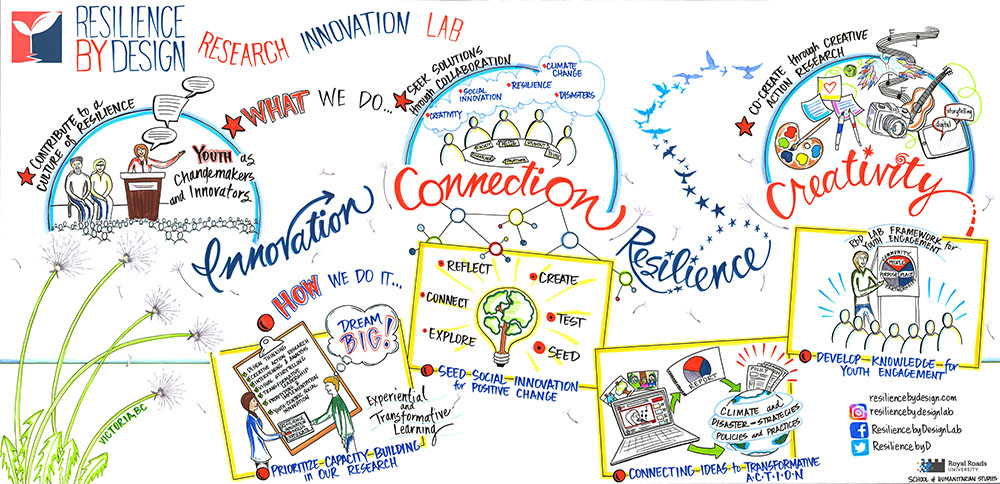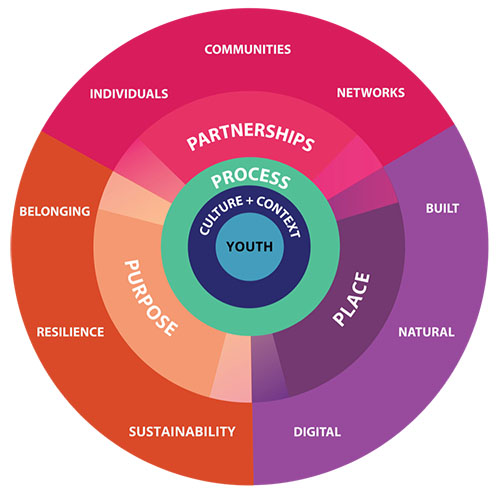 ©ResiliencebyDesign, 2019.
©ResiliencebyDesign, 2019.
By The ResiliencebyDesign Research Innovation Lab
Implications for Public Health
Community and societal resilience is enhanced by the active involvement of youth in disaster risk reduction and recovery. Approaches that empower youth and support equitable youth-adult partnerships should be part of preparedness planning.
Young people can be disproportionately affected by disasters for many reasons. Their developmental stage, their reliance on adults, and their exclusion from many decision-making processes all join together to leave them on the sidelines when disaster strikes.
This one-dimensional understanding of youth perpetuates a mistaken view that children are just a population in need of protection with little to contribute. That view diminishes their potential as knowledgeable, engaged citizens able to meaningfully contribute to their own recovery and to that of their families and communities.
There is, however, a growing global movement of youth and adult allies who believe that stronger youth engagement and voice will contribute to individual, social, economic, and environmental resilience. This turn towards youth empowerment is visible in actions being guided by youth-led and youth-friendly organizations. On their own, or working alongside supportive adult allies, youth are leading and promoting opportunities for them to engage in and lead disaster risk reduction, recovery, resilience, and climate action initiatives. Examples include peer-to-peer wellness and resilience initiatives; youth advisory committees that inform emergency management and recovery task forces; youth-led climate actions and disaster risk reduction strategies; and advocating for youth-informed policies and practices.
Although these efforts represent an important step forward, greater collaborations are necessary between youth and non-traditional stakeholders to collectively achieve the goals for resilience and sustainability set forth in the 2015-2030 Sendai Framework for Disaster Risk Reduction and other global agreements, such as the UN Sustainable Development Goals.
This need for impactful and equitable youth-adult partnerships is what compelled the ResiliencebyDesign Research Lab to conceptualize a youth-informed framework for youth engagement. The 4P Framework for Youth Engagement —also called the 4P Framework—outlines an approach to disaster risk reduction and resilience based on an appreciation of the specific concerns, perspectives, and ideas of children, as well as a commitment to listening to them and taking action. It draws from multiple participatory and creative action research projects with young people. It forms the basis of a principled approach to working with youth and will be accompanied later by a guide that offers practical strategies for applying these principles in collaborative actions to reduce disaster and climate-related risks.

At its core, the 4P framework promotes leveraging youth creativity, insight, and expertise while also contributing to the development of knowledge, skills, and agency. The 4P Framework includes four distinct principles: Process, Partnerships, Place, and Purpose.
The Process principle recognizes that the how of actions is as important as the what. Processes can significantly impact outcomes and can be transformative in and of themselves. This principle encourages youth and their adult partners to co-create and leverage youth-informed and—where possible—youth-led actions in disaster risk reduction and recovery that build their sense of belonging and resilience. This principle encourages youth and adult partners to identify opportunities to stimulate and strengthen youth agency and engagement in ways that acknowledge and respond to power dynamics, social stigmas, inequities, and opportunities.
The Partnerships principle promotes endeavors that proactively identify and include diverse youth communities in collaborative, respectful, and mutually beneficial relationships. It focuses attention on the value of youth-adult partnerships in which youth and adults share power, making decisions together and co-designing processes and actions. It emphasizes the need for such partnerships to engage individuals, communities, and networks across multiple sectors and varied interests. Actions flowing from this principle promote advancement of collaborations shaped by youth-identified outcomes (e.g., more youth friendly spaces or employment opportunities). The goal of such partnerships should include the generation of new opportunities that are inclusive of diverse youth sub-groups, and that provide youth opportunities to explore and act upon their own ideas in culturally responsive and reflexive ways.
The Place principle promotes actions that respect and respond to the connection youth have to place. In this context, place includes the built, natural, and online or virtual spaces and environments that youth inhabit and identify as important. This principle further encourages examining issues of accessibility and relevance when it comes to prioritizing the protection and or rebuilding of places, whether physical or virtual. Inherent is a recognition that youth may rely on and value places not necessarily or commonly identified by adults as important (for example, a local mini-market that serves as a hang-out or a park where kids meet and connect without adult oversight). Flowing from this principle is an understanding that place attachment is an important part of young people renegotiating their identities and their sense of safety in the face of the disruption caused by disasters and climate change.
The Purpose principle promotes policies and activities that recognize that a sense of purpose is as much a driver for youth as it is for adults. Purpose helps build a sense of belonging and agency, and purpose shifts in response to different developmental needs and stages. This principle encourages consideration, therefore, of youth engagement that moves beyond merely participating in activities to being engaged in defining and shaping activities they identify as meaningful, beneficial, and relevant to their lives. This could include activities that combine exploration and creativity, developing employment-related skills, or reducing risks by taking part in local decision making. Purpose and resilience flow from engagement that is sustainable, holistic (integrating environmental, social, and economic factors), and that supports the capacity of youth to foresee, confront, withstand, and recover from disruptions and loss.
Applying the principles of Process, Partnerships, Place, and Purpose is about encouraging youth resilience in the context of change and loss. Having a sense of agency and influence over the decisions that affect their lives leads not only to youth feeling included and valued, but also provides support for them as they develop a sense of their own capacity as leaders and innovators. Active involvement in shaping the direction of their communities contributes to youth resilience.
Taking risks, identifying opportunities that provide hope, and creatively generating ideas that support adaptation can be transformative for youth and their communities. Practicing leadership and innovation buoys youth development while also contributing to a shared potential for a resilient future. Community and societal resilience is only achievable only when all people—including youth—are involved as active citizens and leaders.
Suggested Tools
4P Framework for Youth Engagement
ResiliencebyDesign Research Innovation Lab
Guide to develop youth-adult partnerships for disaster risk reduction, recovery, and climate action.
For a list of all the tools included in this special collection, visit the Children and Disasters Tool Index.
The ResiliencebyDesign Research Innovation Lab at Royal Roads University in Victoria, Canada—led by Robin S. Cox—is a collaborative team of faculty, students, and youth committed to applied, participatory, and creative action research. We believe in the potential of youth as resilience leaders and change makers. Our research focuses on improving local, national, and international policies and practices for risk reduction, disaster recovery, climate adaptation, and low-carbon resilience. Our approach to research features visual storytelling as a method of moving hearts and minds; capacity building as a tool for youth empowerment and engagement; and creative process as means for seeding new ideas and social change.